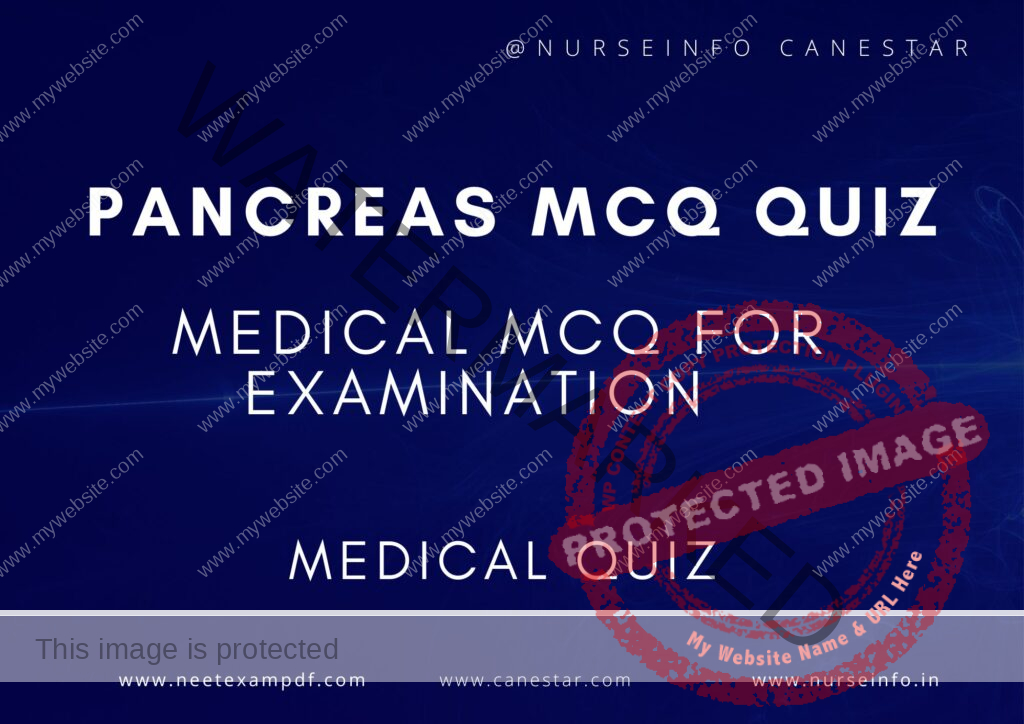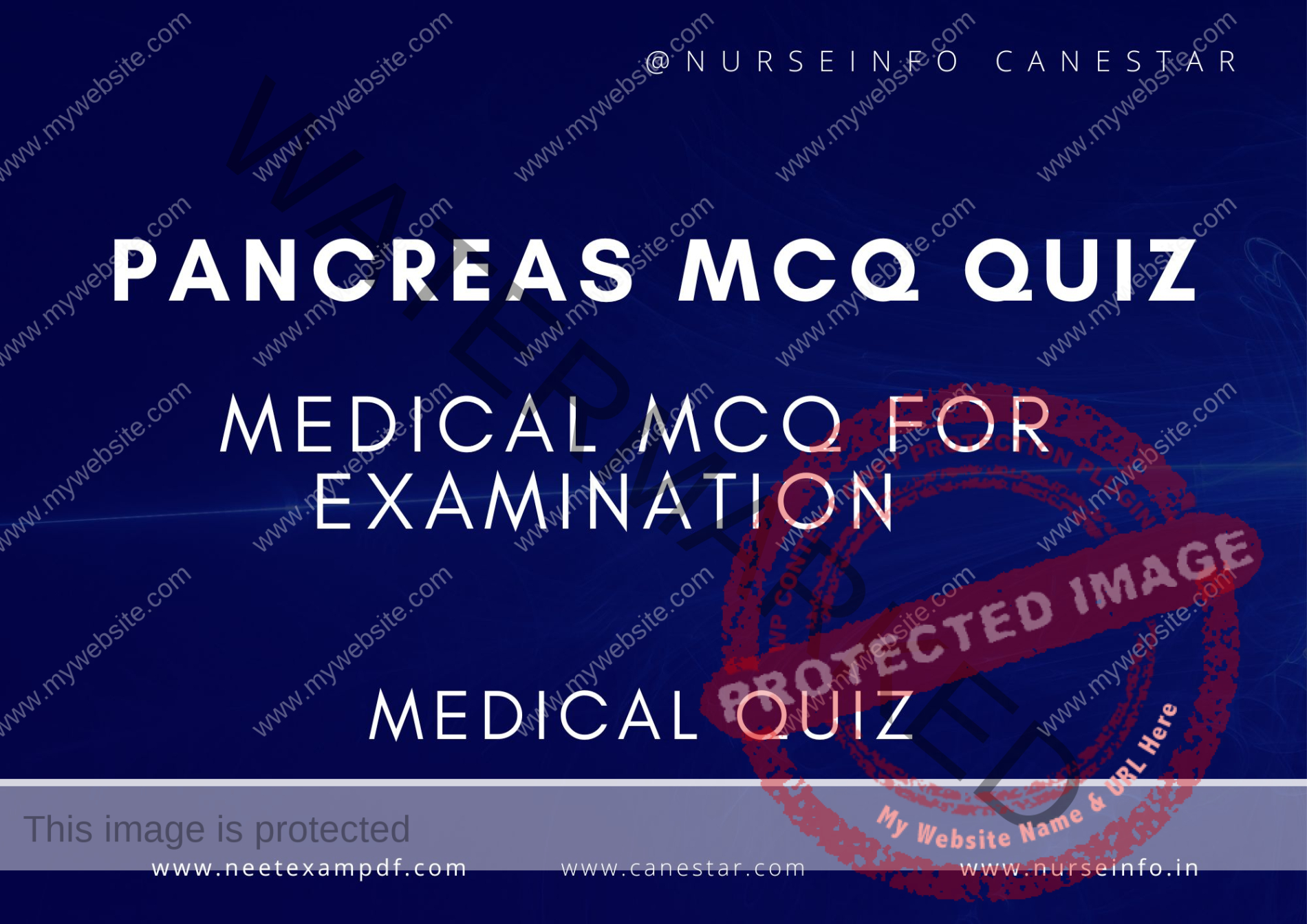MULTIPLE CHOICE QUESTIONS ON PANCREAS PRACTICE QUIZ – MCQS WITH RATIONALE ANSWER – PANCREAS MCQ QUESTIONS WITH RATIONALE
MCQ FOR PANCREAS QUIZ
These mcqs are prepared exclusively for medical professionals for exam preparation. MCQ is helpful to remember the concept on pancreas mcq quiz. This multiple choice questions are helpful for preparation for DHA, PROMETRIC, MOH, HAAD, NCLEX, Medical, NEET and Nursing EXAMINATION
PANCREAS MCQ QUIZ
Question 1
What is the primary function of the pancreas in digestion? A. Production of bile
B. Absorption of nutrients
C. Secretion of digestive enzymes
D. Storage of vitamins
Answer: C. Secretion of digestive enzymes
Rationale: The pancreas secretes digestive enzymes, such as amylase, lipase, and proteases, which are essential for breaking down carbohydrates, fats, and proteins in the small intestine.
Question 2
Which hormone is produced by the beta cells of the pancreas? A. Glucagon
B. Insulin
C. Somatostatin
D. Gastrin
Answer: B. Insulin
Rationale: Beta cells in the pancreas produce insulin, which is crucial for regulating blood glucose levels by facilitating the uptake of glucose into cells.
Question 3
What is the role of glucagon in the body? A. Lowering blood glucose levels
B. Inhibiting gastric secretion
C. Raising blood glucose levels
D. Stimulating insulin production
Answer: C. Raising blood glucose levels
Rationale: Glucagon, produced by the alpha cells of the pancreas, raises blood glucose levels by promoting glycogenolysis and gluconeogenesis in the liver.
Question 4
Which enzyme secreted by the pancreas is responsible for digesting fats? A. Amylase
B. Lipase
C. Trypsin
D. Carboxypeptidase
Answer: B. Lipase
Rationale: Pancreatic lipase is the enzyme responsible for breaking down dietary fats into fatty acids and glycerol in the small intestine.
Question 5
Which part of the pancreas has an endocrine function? A. Acini
B. Ducts
C. Islets of Langerhans
D. Capsule
Answer: C. Islets of Langerhans
Rationale: The Islets of Langerhans are clusters of endocrine cells in the pancreas that produce hormones such as insulin, glucagon, and somatostatin.
Question 6
What is the most common cause of acute pancreatitis? A. Viral infection
B. Gallstones
C. Hypercalcemia
D. Autoimmune disease
Answer: B. Gallstones
Rationale: Gallstones are the most common cause of acute pancreatitis, as they can block the pancreatic duct, leading to inflammation.
Question 7
Which imaging modality is commonly used to diagnose pancreatic diseases? A. X-ray
B. MRI
C. Ultrasound
D. CT scan
Answer: D. CT scan
Rationale: CT scans are commonly used to diagnose pancreatic diseases because they provide detailed images of the pancreas and surrounding structures.
Question 8
What is the role of somatostatin in the pancreas? A. Stimulates insulin secretion
B. Inhibits pancreatic exocrine secretion
C. Promotes glucagon release
D. Enhances digestive enzyme activity
Answer: B. Inhibits pancreatic exocrine secretion
Rationale: Somatostatin, produced by delta cells in the pancreas, inhibits the secretion of pancreatic enzymes and hormones, thereby regulating the digestive process.
Question 9
What condition is characterized by the presence of cystic fibrosis in the pancreas? A. Chronic pancreatitis
B. Acute pancreatitis
C. Exocrine pancreatic insufficiency
D. Pancreatic cancer
Answer: C. Exocrine pancreatic insufficiency
Rationale: Cystic fibrosis can lead to exocrine pancreatic insufficiency due to the blockage of pancreatic ducts by thick mucus, impairing enzyme secretion and digestion.
Question 10
Which type of diabetes is primarily associated with the autoimmune destruction of pancreatic beta cells? A. Type 1 diabetes
B. Type 2 diabetes
C. Gestational diabetes
D. Maturity-onset diabetes of the young (MODY)
Answer: A. Type 1 diabetes
Rationale: Type 1 diabetes is an autoimmune condition where the body’s immune system attacks and destroys the insulin-producing beta cells in the pancreas.
Question 11
What is the significance of elevated amylase and lipase levels in the blood? A. Liver disease
B. Kidney failure
C. Pancreatitis
D. Heart attack
Answer: C. Pancreatitis
Rationale: Elevated levels of amylase and lipase in the blood are indicative of pancreatitis, as these enzymes are released into the bloodstream when the pancreas is inflamed.
Question 12
Which part of the pancreas is most commonly affected by pancreatic cancer? A. Head
B. Body
C. Tail
D. Neck
Answer: A. Head
Rationale: The head of the pancreas is the most common site for pancreatic cancer, which can lead to obstruction of the bile duct and jaundice.
Question 13
What is the primary function of the pancreatic ducts? A. Store digestive enzymes
B. Transport digestive enzymes to the small intestine
C. Produce insulin
D. Absorb nutrients
Answer: B. Transport digestive enzymes to the small intestine
Rationale: The primary function of the pancreatic ducts is to transport digestive enzymes from the pancreas to the small intestine where they aid in digestion.
Question 14
Which hormone inhibits both insulin and glucagon secretion? A. Somatostatin
B. Secretin
C. Cholecystokinin
D. Ghrelin
Answer: A. Somatostatin
Rationale: Somatostatin inhibits the secretion of both insulin and glucagon, helping to regulate the balance of these hormones.
Question 15
What is the name of the condition where the pancreas is inflamed over a long period, leading to permanent damage? A. Acute pancreatitis
B. Chronic pancreatitis
C. Pancreatic necrosis
D. Pancreatic cyst
Answer: B. Chronic pancreatitis
Rationale: Chronic pancreatitis is a condition where long-term inflammation leads to permanent damage and scarring of the pancreas.
Question 16
What surgical procedure is commonly performed to remove a pancreatic tumor? A. Cholecystectomy
B. Whipple procedure
C. Appendectomy
D. Colectomy
Answer: B. Whipple procedure
Rationale: The Whipple procedure, or pancreaticoduodenectomy, is a common surgical method for removing tumors from the head of the pancreas.
Question 17
Which cell type in the pancreas produces digestive enzymes? A. Alpha cells
B. Beta cells
C. Delta cells
D. Acinar cells
Answer: D. Acinar cells
Rationale: Acinar cells in the pancreas produce and secrete digestive enzymes into the small intestine to aid in digestion.
Question 18
What is a common symptom of pancreatic cancer? A. Frequent urination
B. Jaundice
C. Elevated heart rate
D. Hypertension
Answer: B. Jaundice
Rationale: Jaundice, or yellowing of the skin and eyes, is a common symptom of pancreatic cancer, especially when the tumor obstructs the bile duct.
Question 19
Which diagnostic test measures the functionality of the exocrine pancreas? A. Fasting blood glucose
B. Hemoglobin A1c
C. Fecal elastase test
D. Oral glucose tolerance test
Answer: C. Fecal elastase test
Rationale: The fecal elastase test measures the level of elastase in stool, which is an indicator of exocrine pancreatic function and enzyme production.
Question 20
Which substance is secreted by the pancreas to neutralize stomach acid in the small intestine? A. Bicarbonate
B. Hydrochloric acid
C. Pepsinogen
D. Intrinsic factor
Answer: A. Bicarbonate
Rationale: The pancreas secretes bicarbonate into the small intestine to neutralize stomach acid, creating an optimal environment for digestive enzymes to function.


